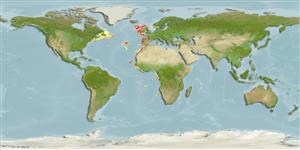>
Gadiformes (Cods) >
Lyconidae (Atlantic hakes)
Etymology: Lyconus: From Lykon, a Trojan warrior slain by Peneleus; mythology.
Environment: milieu / climate zone / depth range / distribution range
বাস্তুসংস্থান
সামুদ্রিক ব্যথিডিমারসাল সমুদ্র তলদেশবিহারী; গভীরতার পরিসীমা 150 - 997 m (Ref. 12204). Deep-water; 60°N - 30°S, 68°W - 14°E
Northwest Atlantic: off Canada. Northeast Atlantic: southwest of Ireland, Madeira, and off Saharian coasts (Ref. 6524).
আকৃতি / ওজন / Age
Maturity: Lm ? range ? - ? cm
Max length : 52.5 cm SL পুরুষ/ লিঙ্গ অনিধর্ারিত ; (Ref. 58452)
পৃষ্ঠীয় নরম পাখনা দন্ড (মোট ): 9-11. Caudal fin small (Ref. 12204).
Rare species (Ref. 12204, 58452) found on the muddy slope of the continental shelf (Ref. 6524). Juveniles are captured from 150-700 m depth range (Ref. 58452). Biology unknown (Ref. 12204). Minimum depth reported taken from Ref. 58452.
Life cycle and mating behavior
পরিপক্কতা | প্রজনন | ডিম ছাড়া | ডিমসমূহ | ডিম্বধারন ক্ষমতা | শুককীট
Coad, B.W., 1995. Encyclopedia of Canadian fishes. Canadian Museum of Nature and Canadian Sportfishing Productions Inc. Singapore. (Ref. 12204)
IUCN Red List Status (Ref. 130435)
Threat to humans
Harmless
Human uses
মৎস্য: আকর্ষণবিহীণ
আরো তথ্য
প্রচলিত নাম সমূহপ্রতিনাম সমূহবিপাকশিকারী প্রাণী সমূহপরিবেশ বিষাক্ততাবিদ্যাপ্রজনন পরিপক্কতা ডিম ছাড়া ডিমের সংগ্রহ ডিম্বধারন ক্ষমতা ডিমসমূহEgg development
Age/Sizeবৃদ্ধিLength-weightLength-lengthLength-frequenciesমরফোমেট্রিক্সবহিঃ অঙ্গ সংস্থানশুককীট শুককীটের সত্রিুয়তা নির্বাচন প্রাচুর্য BRUVS
সূত্র সংখ্যা এ্যাকুয়াকালচার (জলজ পালন) এ্যাকুয়াকালচার নকশা বংশ বংশানুগতিবিদ্যাElectrophoresesউতরাধিকার সুত্রে পাওয়া যোগ্যতারোগ প্রক্রিয়াজাতকরণ NutrientsMass conversion
হাতিয়ার
Special reports
Download XML
ইন্টারনেট সুত্র
Estimates based on models
Preferred temperature (Ref.
123201): 7.8 - 11.4, mean 10.2 °C (based on 42 cells).
Phylogenetic diversity index (Ref.
82804): PD
50 = 0.7500 [Uniqueness, from 0.5 = low to 2.0 = high].
Bayesian length-weight: a=0.00389 (0.00180 - 0.00842), b=3.12 (2.94 - 3.30), in cm total length, based on all LWR estimates for this body shape (Ref.
93245).
ট্রফিক পর্যায়ে (Ref.
69278): 3.7 ±0.3 se; based on size and trophs of closest relatives
স্থিতিস্থাপক (Ref.
120179): মাধ্যম , সর্বনিম্ন প্রজন দ্বিগুনের সময় ১.৪-৪.৪ বৎসর (Assuming tmax>3).
Fishing Vulnerability (Ref.
59153): Moderate to high vulnerability (46 of 100).
